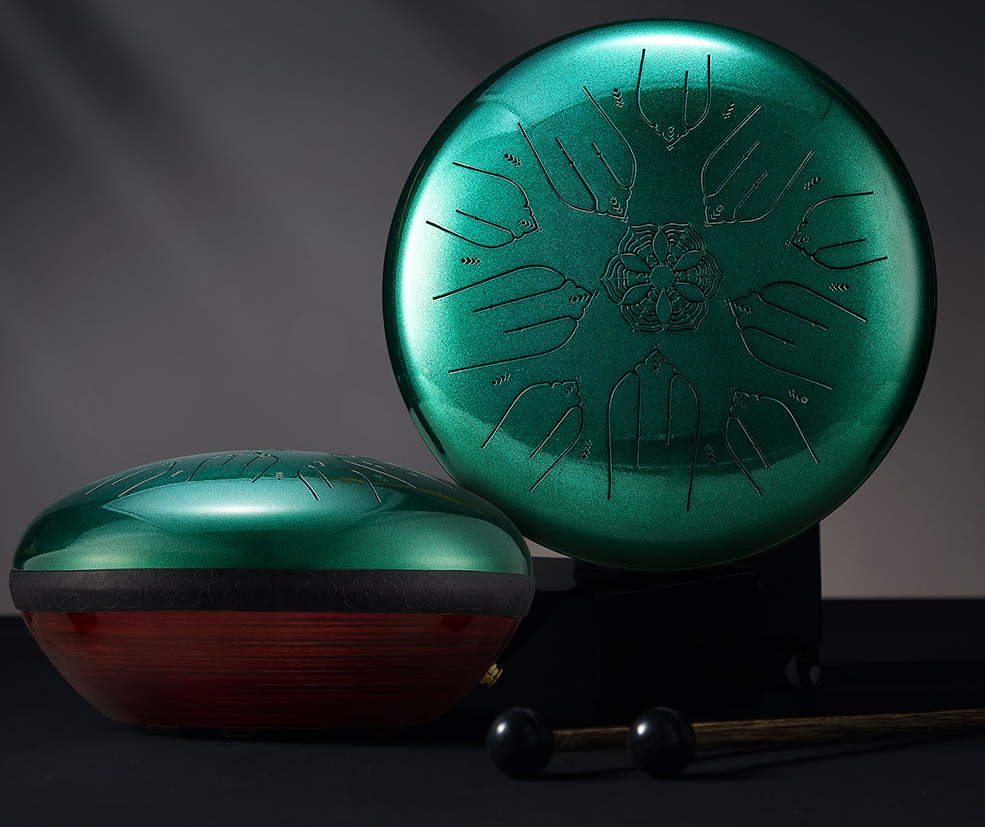The Steel tongue drum and the Handpan are often compared due to their somewhat similar appearances. However, they are two distinctly different instruments, with significant differences in origin, structure, sound, playing technique, and price.
Simply put, they can be metaphorically described as follows:
The Handpan is like a ”supercar in the instrument world“ – meticulously designed, expensive, with a deep and complex sound, highly expressive, and sought after by professional musicians and serious enthusiasts.
The Steel tongue drum is like an ”user-friendly family smart car“ – easy to learn, affordable, with an ethereal and soothing sound, making it an excellent choice for musical beginners and daily relaxation.
Below is a detailed comparison across several dimensions:
Steel tongue drum vs. Handpan: Core Differences Comparison Table
| Feature | Steel tongue drum | Handpan |
| Origin & History | Modern Chinese invention (post-2000s), inspired by ancient Chinese bianzhong (chime stones), Qing (stone chimes), and the steel tongue drum. Designed with ease of play and therapy in mind. | Swiss invention (early 2000s), developed by PANArt (Felix Rohner and Sabina Schärer). Inspired by the steelpan from Trinidad and Tobago. |
| Structure & Form | - Single-shell body: Typically formed from a single dome. - Tongues on top: Raised tongues (tabs) are on the top surface, arranged around a central base. - Bottom hole: The bottom usually has a large central hole. |
- Two-shell body: Comprises two deep-drawn hemispherical steel shells bonded together, resembling a UFO. - Tone fields on top: The upper shell (Ding) has a central raised fundamental note area, surrounded by 7-8 note fields which are depressed into the top surface. - Top shell hole: The upper shell has an opening called the “Gu”. |
| Sound & Resonance | - Sound: Ethereal, clear, wind-chime-like, relatively shorter sustain, simpler resonance. - Feel: More “celestial” and Zen-like, as if coming from afar. |
- Sound: Deep, rich, full of overtones, long sustain, very strong resonance, sound seems to swirl within the cavity. - Feel: More “soulful” and rhythmic, with a enveloping sound quality. |
| Scale & Tuning | - Fixed tuning: Comes from the factory pre-tuned to a fixed scale (e.g., C major pentatonic, D natural minor). - Varied choices: Various scales are available on the market, suitable for playing different styles of music. |
- Custom tuning: Each Handpan has a unique scale, customized by the maker, often using non-traditional scales. - Unique: Even the same model can have subtle sound variations between batches, making each more unique. |
| Playing Technique | - Played primarily by striking the tongues with palms or fingertips; can also be played with soft mallets. - Relatively simple technique, focused mainly on melodic play. |
- Played by precisely tapping the note fields on the upper shell with fingertips and palms. - Complex technique, capable of producing melody, rhythm, harmony, and even special effects by rubbing/tapping different parts. |
| Price & Accessibility | - Affordable: Entry-level models typically cost a few hundred RMB; high-end handcrafted models can reach several thousand RMB. - Very low barrier: Quick to pick up with zero prior experience; a perfect beginner instrument. |
- Expensive: Entry-level brands typically cost thousands to tens of thousands of RMB; instruments from top masters can exceed 100,000 RMB. - High barrier: Requires significant musical sense and practice to master its complex techniques. Purchasing channels are limited, and wait times can be long. |
| Primary Uses | - Music initiation, personal relaxation, sound healing, yoga/meditation, decorative piece. | - Professional performance, street busking, music composition, deep musical exploration. |
How to Tell Them Apart Intuitively?
Look at the front (top):
Steel tongue drum: The surface has raised tongues, resembling petals or tongues.
Handpan: The surface has depressed note fields, with a raised “Ding” in the center.
Listen to the sound:
Steel tongue drum: When struck, the sound is clear, ethereal, like a wind chime or bianzhong, and fades relatively quickly.
Handpan: When struck, the sound has strong resonance and a characteristic “hum” from overtones, with a long, lingering sustain.










